RAF Molesworth
Royal Air Force Molesworth or more simply RAF Molesworth is a Royal Air Force station located near Molesworth, Cambridgeshire, England with a history dating back to 1917.
RAF Molesworth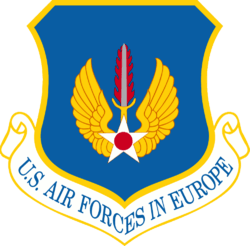 | |
|---|---|
| Near Molesworth, Cambridgeshire in England | |
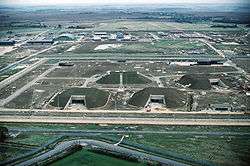 Ground launched cruise missile shelters at RAF Molesworth during 1989 | |
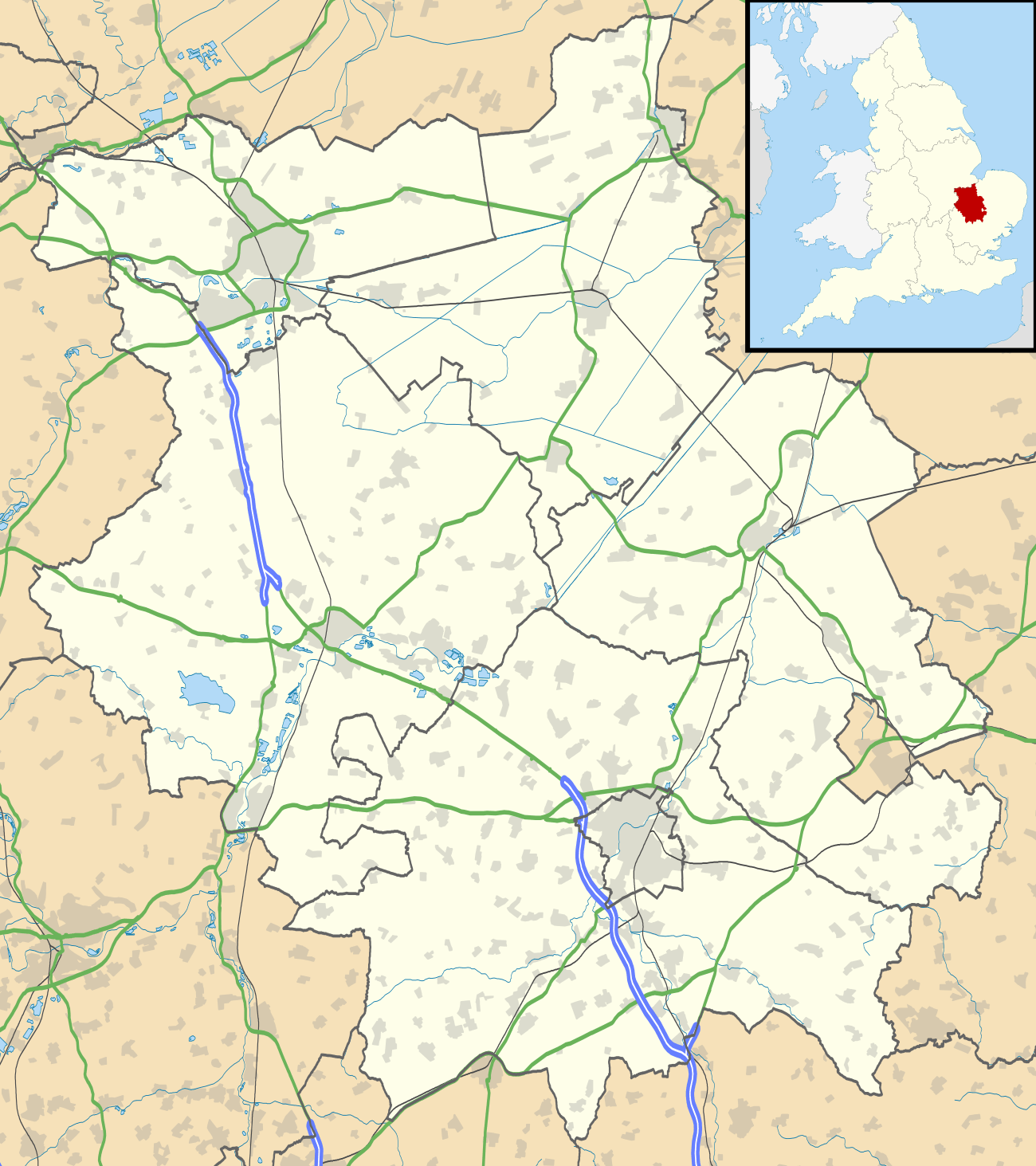 RAF Molesworth Shown within Cambridgeshire | |
| Coordinates | 52°22′46″N 000°24′18″W |
| Type | RAF station (US Visiting Forces) |
| Area | 272 hectares (670 acres)[1] |
| Site information | |
| Owner | Ministry of Defence |
| Operator | US Air Force |
| Controlled by | US Air Forces in Europe - Air Forces Africa |
| Condition | Operational |
| Site history | |
| Built | 1940 |
| In use | 1939 – 1942 (Royal Air Force) 1942 – 1945 (US Army Air Forces) 1945 – 1951 (Royal Air Force) 1951 – present (US Air Force) |
| Garrison information | |
| Garrison | 423d Air Base Group |
| Airfield information | |
| Elevation | 77 metres (253 ft) AMSL |
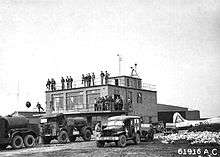
Its runway and flight line facilities were closed in 1973 and demolished. New facilities were constructed to support ground-launched cruise missile operations in the early 1980s. It was one of the two British bases to house cruise missiles and a focus for protests. It is now a non-flying facility under the control of the United States Air Force (USAF), and is one of two Royal Air Force (RAF) stations in Cambridgeshire currently used by the United States Air Forces in Europe (USAFE). Molesworth, RAF Alconbury and RAF Upwood were considered the "Tri-Base Area" due to their close geographic proximity and interdependency until RAF Upwood closed in late 2012.
RAF Alconbury and RAF Molesworth were the last Second World War era Eighth Air Force airfields in the United Kingdom that were still actively in use and controlled by the United States Air Force. It was from Molesworth on 4 July 1942 that the first USAAF Eighth Air Force mission was flown over Nazi-occupied territory.
On 8 January 2015 it was announced that the US Air Force would be withdrawn from RAF Molesworth, along with RAF Mildenhall and RAF Alconbury.[2] Another announcement, in early 2016, stated that the site was one of twelve that will be sold as part of the strategy for the MOD Estate, although no date for the sale was given.[3] In February 2019, the Ministry of Defence announced that RAF Molesworth would be retained.
Overview
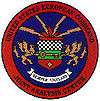
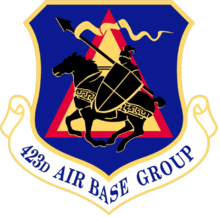
Molesworth is home to three Major Command (MAJCOM) branch sites: the United States European Command (USEUCOM) Joint Intelligence Operations Center Europe Analytic Center (JAC), United States Africa Command (USAFRICOM) Intelligence and Knowledge Directorate-Molesworth (J2-M), North Atlantic Treaty Organization (NATO) Intelligence Fusion Centre (IFC), and is garrisoned by the United States Air Force 423rd Air Base Group (423 ABG), located at RAF Alconbury.
The role of the JAC is to process and analyse military information from a variety of sources for the benefit of the United States and NATO. Responsibility consists of eighty-three countries across Europe, along with the Middle East and the Mediterranean.
The JAC reports to the Director of Intelligence (J2), Headquarters, United States European Command, in Stuttgart-Valhingen, Germany.
Molesworth employs over 750 personnel including US, British and foreign military as well as US and British civilians. Because of past gaps in operations and demolishing of buildings and infrastructure, RAF Molesworth contains very limited support operations. As such, it relies solely upon the 423rd ABG for all non-JAC related support functions like postal services, banking and telecommunications connectivity.
RAF Molesworth is about 1.011 sq mi (2.618 km2) in area.
History
First World War
The Royal Flying Corps selected a site for an airfield in Huntingdonshire near the village of Old Weston during the First World War. The first flying unit to arrive at the aerodrome was 75 Squadron. No. 75 Squadron flew B.E.2s, a reconnaissance and artillery spotter aircraft which saw extensive combat use over the Western Front, from Molesworth for training and pilot proficiency.[4] The squadron remained at this airfield until September 1917.[5] After the Great War ended, the airfield was abandoned during the inter-war years. Some of the buildings were taken over by the surrounding farms with many of them still in use today.
Second World War
RAAF/RAF use
At the start of the Second World War the Air Ministry selected the area as the site for what would become RAF Station Molesworth. The airfield was built between 1940 and 1941. The first flying unit was Royal Australian Air Force 460 Squadron when it formed here on 15 November 1941 with Vickers Wellington IVs. No 460 Squadron departed Molesworth on 4 January 1942.[6] RAF Bomber Command 159 squadron moved in shortly afterwards, however this unit did not remain long, moving to the Middle East on 12 January 1942.[7]
USAAF use
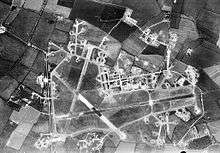
Molesworth was one of the early Eighth Air Force stations allocated to the United States Army Air Forces (USAAF). In February 1942 General Ira Eaker and four US staff members inspected Molesworth for possible American use, and during 1942 the facility was improved to Class A airfield standard, with all of its runways extended to American specifications for heavy 4-engined bombers. The main runway was lengthened to 2,000 yards and the number of hardstands increased to fifty. It was given USAAF designation as Station 107.
From 16 September 1943 – 18 June 1945, Molesworth served as headquarters for the 41st Combat Bombardment Wing of the 1st Bomb Division.
15th Bombardment Squadron

The first USAAF tenant on Molesworth was the 15th Bombardment Squadron, arriving on 9 June 1942 from RAF Grafton Underwood. The squadron flew the Douglas Boston III (A-20) light bomber. The 15th was originally part of the 27th Bombardment Group (Light), assigned to Fifth Air Force in the Philippine Islands. However the group's planes (A-24s), did not arrive by 7 December 1941, and due to the deteriorating situation in the Philippines after the Japanese invasion, they were diverted to Australia. Surviving members of the group reformed into a combat unit in Australia and fought in the Dutch East Indies and New Guinea Campaigns.
When the 27th Bombardment Group was inactivated and transferred back to the United States for re-equipping, the surviving members of the group were first transferred back to the United States, then to the UK in May where they received their Bostons from No. 226 Squadron RAF. The men and aircraft were organised and formed as the 15th Bomb Squadron, the 15th LBS having been a part of the 27th while in training during 1940/41 before being inactivated prior to the groups deployment to the Philippines. With the pilots having had extensive combat experience against the Japanese in the Pacific War, these airmen's mission was to train with their RAF counterparts in preparation for the upcoming Eighth Air Force strategic bombing campaign against the Germans.
After a few weeks of familiarisation training with the new aircraft, on 4 July 1942, six American crews from the 15th Bomb Squadron joined with six RAF crews from RAF Swanton Morley for a low-level attack on Luftwaffe airfields in the Netherlands, becoming the first USAAF unit to bomb targets in Europe. The 4 July raid had been specifically ordered by General Henry H. "Hap" Arnold and approved by President Roosevelt. Arnold believed that 4 July would be an ideal day for the USAAF to open its strategic bombing campaign against the Nazis, but General Carl Spaatz did not have any of his heavy Eighth Air Force bomb groups ready for operational missions. Two of the 15th's planes did not return from the mission, along with one RAF aircraft. The squadron commander, Captain Charles Kegelman, plane was shot up badly and almost did not return. Spaatz considered the mission a "stunt" triggered by pressure in the American press who believed the people of both the United States and Great Britain needed a psychological boost. However, Kegleman was awarded the Distinguished Service Cross and its British equivalent for his valour on that Fourth of July mission, the first Eighth Air Force airman to receive the nation's second highest combat decoration.
The 15th flew most of its missions from Molesworth in its Bostons, and did not receive USAAF Douglas A-20 Havoc aircraft until 5 September. The squadron was transferred to RAF Podington until 15 September where it flew a few missions before being transferred to Twelfth Air Force for support of Allied landings in North Africa on 15 October 1942.
303d Bombardment Group
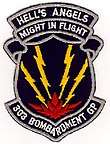
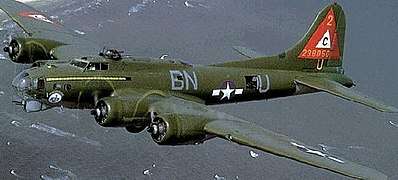
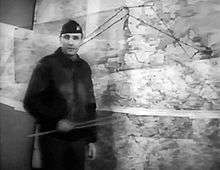
With the departure of the 15th Bomb Squadron, Molesworth was occupied by the Boeing B-17 Flying Fortresses of the 358th Bombardment Squadron, the first of four squadrons that would comprise the 303d Bombardment Group. The 303d would remain at Molesworth until shortly after V-E Day in late May 1945.
The 303d Bombardment Group consisted of the following squadrons:
- 358th Bombardment Squadron (Code VK)
- 359th Bombardment Squadron (Code BN)
- 360th Bombardment Squadron (Code PU)
- 427th Bombardment Squadron (Code GN)
The 358th flew the first mission for the group on 17 November 1942. The group would become one of the legendary units of the Eighth Air Force. Initially missions were conducted against targets such as aerodromes, railways, and submarine pens in France until 1943, then flying missions into Germany itself.
The 303d took part in the first penetration into Germany by heavy bombers of Eighth Air Force by striking the U-boat yard at Wilhelmshaven on 27 January 1943 then attacked other targets such as the ball-bearing plants at Schweinfurt, shipbuilding yards at Bremen, a synthetic rubber plant at Huls, an aircraft engine factory at Hamburg, industrial areas of Frankfurt, an aerodrome at Villacoublay, and a marshalling yard at Le Mans.
The 303d received a Distinguished Unit Citation for an operation on 11 January 1944 when, in spite of continuous attacks by enemy fighters in weather that prevented effective fighter cover from reaching the group, it successfully struck an aircraft assembly plant at Oschersleben.
The group attacked gun emplacements and bridges in the Pas de Calais area during the invasion of Normandy in June 1944, and bombed enemy troops to support the breakthrough at Saint-Lô in July 1944. It struck airfields, oil depots, and other targets during the Battle of the Bulge, and bombed military installations in the Wesel area to aid the Allied assault across the Rhine in March 1945.
The last mission for the 303d was flown on 25 April 1945 when it attacked an armament works in Pilsen. During its combat tour the group flew 364 missions comprising 10,271 sorties, dropped 26,346 tons of bombs and claimed 378 enemy aircraft shot down, with another 104 probables. The group also saw 817 of its men killed in action with another 754 becoming prisoners of war.
On 31 May 1945, the 303d Bomb Group left Molesworth, moving to Casablanca, French Morocco. A monument to the 303rd BG stands inside the main entrance and is accessible to the public.[8]
Bob Hope entertained base personnel on 6 July 1943.[8] American news correspondent Walter Cronkite flew on a 303d Bombardment Group mission while reporting the war.[8] American servicemen from RAF Molesworth married more English women during Second World War than servicemen from any other American base in England.[8]
Wulfe Hound
A B-17F-27-BO from the 360th BS, nicknamed "Wulfe Hound" (41-24585; squadron code PU-B) was the first Flying Fortress to be captured by the Luftwaffe.
On 12 December 1942, after attacking railroad marshalling yards in the Rouen-Sotteville area of France, "Wulfe Hound" was attacked by Focke-Wulf Fw 190 fighters. Damage forced the pilot, 1Lt Paul F. Flickenge to make a wheels-up landing in a hayfield near Melun (60 miles southeast of Paris). Eight of the crew were captured but 1Lt Gilbert T Showalter (navigator) and 2Lt Jack E. Williams (co-pilot) were able to evade capture.[9]
German personnel were able to transport the B-17 to Leeuwarden Air Base in the Netherlands where it was repaired and put in flyable condition. It was examined and tested at the Luftwaffe Test and Evaluation Center at Rechlin. "Wulfe Hound" was first flown by the Germans on 17 March 1943, followed by more testing and development of fighter tactics against B-17s. It was transferred to the Kampfgeschwader 200 special operations wing at Rangesdforf, Germany on 11 September 1943 and took part in training and clandestine missions between May and June 1944.
On 20 April 1945 the aircraft was caught in an Allied air-raid on Oranienburg Airfield and was damaged. In 2000, the Germany government started redeveloping this former airfield and parts of "Wulfe Hound" were recovered and are preserved at Sachsenhausen Memorial Store.[10]
303d Bombardment Group Legacy
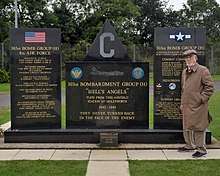
The 303d Bomb Group was inactivated in Morocco on 23 July 1945. Personnel demobilised and the B-17 aircraft sent to storage.
During the Cold War, the United States Air Force Strategic Air Command 303d Bombardment Wing, Medium flew Boeing B-29 "Superfortresses" and later Boeing B-47 "Stratojet" from Davis-Monthan AFB Arizona beginning in 1951. The wing was bestowed the honours and history of the USAAF 303d Bombardment Group in 1952. The wing was inactivated in 1964 with the phaseout of the B-47.
As described below, in the late 1980s the group was briefly reactivated at Molesworth as the USAFE 303d Tactical Missile Wing.
The Cold War
Back to Royal Air Force control
On 1 July 1945 the Americans turned the station back to the RAF, who quickly chose it to be a training base for their new jet aircraft. The first jet unit, 1335 Conversion Unit, arrived on 27 July, flying Gloster Meteor IIIs. It would be joined over the next year by several transient aircraft detachments and units.
On 10 October 1946, 1335 Conversion Unit left RAF Molesworth, and the airfield was placed under 'care and maintenance'.
USAF use

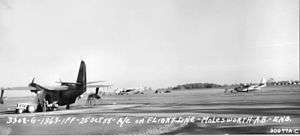
As the Cold War increased in intensity, the US Air Force began looking to expand in Western Europe. RAF Molesworth was chosen in 1951 to become home to the 582d Air Resupply Group. The station was enlarged with main runway extensions and modern facilities. After much runway work by the 801st Engineer Battalion, the group moved from Great Falls, Montana to the station in February 1954.
582d Air Resupply Group
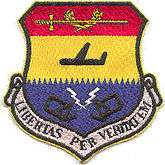
In September 1953, after the Korean Armistice was signed that ended active conflict on the Korean peninsula the existing USAF Air Supply Wings were reduced to air resupply groups. The groups were approximately one half the size of the former wings and consisted of two squadrons, one flying squadron and one support squadron—as compared to six squadrons in each wing before the reorganisation. The unit was equipped with twelve B-29s, four Grumman HU-16 Albatross, Amphibians, three C-119 Flying Boxcars (able to use RATO gear) and a C-47.
Although the unit was identified as an Air Resupply Group, the unit's name was deliberately misleading, as the mission of the 582nd was support of special operations over Soviet occupied territory.
The 582nd was assigned directly to Third Air Force and provided the bulk of its air support to the Army 10th Special Forces Group, which had been transferred in total from Fort Bragg, North Carolina, to Bad Tölz, West Germany. For the next two and one-half years, the 582nd worked closely with the 10th Group providing airdrop, resupply, and airland support with its assigned B-29 and C-119 aircraft.
The versatile SA-16 was utilised for amphibious missions, including night water-infiltration/exfiltration operations. Assigned SA-16s were also tasked to fly classified courier missions throughout the Mediterranean, Middle East and southern Europe.
On 25 October 1956 the 582nd was replaced by the 42nd Troop Carrier Squadron. The 42nd flew HU-16s, C-47s, C-119s and C-54 Douglas Skymaster cargo transport aircraft from Molesworth until 3 May 1957 when it moved 13 miles up the road to RAF Alconbury. However the squadron had a short life at Alconbury and was inactivated on 8 December 1957. The C-54s and C-47s were sent to Rhein-Main Air Base, West Germany, and the C-119s were sent to the 322nd Air Division at Évreux-Fauville Air Base, France.
Reserve status
With the departure of the 42d Troop Carrier Squadron, Molesworth was put into a standby status, with the occasional aircraft using the airfield. In April 1959, with the closing of the active runway at RAF Burtonwood, in Cheshire WB-50Ds of the 53d Weather Reconnaissance Squadron used the runway at Molesworth, although the unit was officially assigned to RAF Alconbury. The squadron was reassigned to RAF Mildenhall in August. Station personnel was reduced to a small maintenance staff and for the next twenty years the facility was in reserve status with upkeep provided by Alconbury.
In 1973 the airfield was officially deactivated. The only remaining structures on the station were a small arms firing range, used by USAF personnel for target practice, a compound for surplus and obsolete USAF vehicles manned by civilian USAF employees, a derelict watchtower on the western perimeter of the base, a warehouse and the base gas station which was being used as a fire station. This fire station housed one engine and a small crew for fire protection. These firefighters were USAF personnel from RAF Alconbury (10th CES/FD), assigned to RAF Molesworth, on a rotating basis. Two other structures also remained; the canteen and the chapel. Roofing structure was removed from the former and oak flooring from the latter by two local farmers who bought the buildings in 1975.
The airfield was unfenced and openly accessible to all, and local farmers grazed sheep on wired-off sections where the runway had formerly been. A solitary pest controller known locally as John the Rabbit catcher lived in a caravan just outside the former site of the north-west gate, and local people practised for their driving tests on the remaining concrete road surfaces.
Molesworth did serve as an American education and housing centre, offering military family housing for personnel assigned to RAF Alconbury, along with an elementary and junior high/high school offering grades 1 - 6 and 7 - 10 respectively, for dependents of servicemen and women from nearby stations including RAF Chicksands, RAF Chelveston and RAF Alconbury. By the early 1980s military-related activity at Molesworth was almost entirely absent. The USAF maintained only a small waste disposal and warehousing operation manned by a small civilian USAF staff working in a few prefab offices next to a large junkyard for obsolete USAF vehicles in a small section of the base near the north entrance to the site, and a small-arms training firing range set back about 100m from the western perimeter, used once or twice a month by USAF Security Police from nearby USAF bases.
303d Tactical Missile Wing and cruise missiles


Following the 1979 NATO Double-Track Decision, in June 1980, RAF Molesworth was selected[11] as one of two British bases for the US Air Force's mobile nuclear armed Ground Launched Cruise Missiles or GLCMs. These were the "Gryphon" type derived from the sea-launched "Tomahawk". The majority of GLCMs were deployed at RAF Greenham Common, the other UK base.
During the early 1980s, the Ministry of Defence rebuilt Molesworth. All of the Second World War runways, taxiways, hardstands, as well as a 9,000 ft jet runway laid down in the 1950s were removed. The only surviving remnants of the Second World War era are two T.2 hangars and one J-Type hangar on the former airfield. A cluster of wartime buildings, including Nissen huts exist just east of the facility, at the intersection of the B660 and Brington Road at the edge of Old Weston.[8] Crumbling buildings, mostly from the 1950s were also demolished and removed. In its place an infrastructure to accommodate nuclear missiles (storage bunkers, watch tower, machine guns pits) was built. Each of the four bunkers contained three bays housing one BGM-109G Ground Launched Cruise Missile Transporter Erector Launcher (TEL) and sixteen missiles, and two launch control centres and a MAN KAT1 8x8 tractor. As Molesworth no longer had a runway, the missiles were flown into Alconbury before being transferred by road to Molesworth.
On 12 December 1986 the 303d Tactical Missile Wing was activated. However, the missiles and the wing did not stay long; the United States and the Soviet Union signed the Intermediate-Range Nuclear Forces Treaty in 1987 which led to the removal of all nuclear missiles from the station by October 1988. The 303d TMW was inactivated on 30 January 1989.
The infrastructure from the GAMA (GLCM Alert and Maintenance Area) is partially intact[12] and offers a unique reminder of the Cold War.
Joint Analysis Center
On 11 January 1990 the RAF announced construction would begin later that year to house the United States European Command's new intelligence analysis centre. This facility would become known as the Joint Analysis Center (JAC). The JAC has provided intelligence support for US and NATO missions in the Middle East and the Balkans while providing global assistance in the War on Terror.
A 2017 Office of the Inspector General report recorded that the base the also contained other similar units: U.S. Africa Command (AFRICOM) Directorate for Intelligence unit (J2-M), Defense Intelligence Agency's Regional Support Center, NATO's Intelligence Fusion Center, the Regional Joint Intelligence Training Facility, and the Under Secretary of Defense for Intelligence’s Battlefield Information Collection and Exploitation System (BICES) unit. The Joint Analysis Center and AFRICOM J-2M employed about 460 U.S. military personnel and Department of Defence civilians.[13]
Planned station closure
On 8 January 2015 the UK Ministry of Defence announced that the US Air Force activities at RAF Molesworth and RAF Alconbury would be consolidated at RAF Croughton in Northamptonshire.[14] In February 2019 the Ministry of Defence announced that RAF Molesworth would be retained.[15]
Anti-nuclear protests

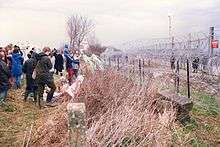
The decision in 1980 to house 64 cruise missiles at Molesworth made the station a focus of protest.[16] In May 1981, members of the Fellowship of Reconciliation, a peace organisation on a cycle pilgrimage from Iona Abbey to Canterbury Cathedral called at the unfenced base. The Bishop of Huntingdon, Gordon Roe planted a cherry tree. On Holy Innocents Day, 28 December 1981 members of the Fellowship of Reconciliation, Christian CND, Green CND and others established a peace camp at the south-east gate of the station to protest against the planned deployment.[17]
Unlike Greenham Common Women's Peace Camp, Molesworth People's Peace Camp included both women and men. The Christian (particularly Quaker) presence at the Camp remained throughout its existence and was supplemented by people of other faiths and of none. An all-faiths chapel, a mainly wood structure called Eirene (Greek for 'peace') was gifted by Architects For Peace.[18][19] The camp became a link in a Europe-wide network of centres for non-violent direct action in opposition to NATO plans to deploy Pershing II and GLCM missiles.
The People's Peace Camp was mainly established by what became known as Peace Corner which opened on to the base and a disused loop of the B660. This camp was evicted in July 1983 but was re-established along Warren Lane bridleway to the west of the station.[20] This right of way lay on the border between Cambridgeshire and Northamptonshire and the county boundary crossed from one side of the track to the other in the middle of the new site. This confused the issue of ownership so that no legal action was attempted to evict the protesters there. The camp predated Rainbow Village and eventually located at what was to become Delta Gate, so it was the only permanent sign of protest. Other camps were set up on the east side.
The original Eirene Chapel was removed but a new one was started on the base, using rubble from the old runway, brick and other material. The foundation stone was laid by Satish Kumar on Easter Sunday 1984.[21] It was never completed.[22]
In August 1984, part of the then-unfenced airfield was occupied by a mixed group of environmental activists, New Age travellers, Quakers, anarchists and peace campers. The occupation, and the 'Rainbow Village' that it became, remained on MOD land for nearly six months. A magazine Molesworth Bulletin was printed in a bender. The members of Rainbow Village and peace activists used an area of land to grow wheat which was later sent to Eritrea.[23] The land while technically military at this point was open fields without fencing which had not been in use since the Second World War.
On 6 February 1985, 1,500 troops and police were deployed to secure the seven-mile station perimeter for the Ministry of Defence. The operation has been described as "perhaps the most dramatic occurrence in all the peace and anti-nuclear campaigns of the 1980s" in the UK.[24] The troops had been training for weeks in the rapid deployment of a three-metre-high (9.8 ft), six-roll, Dannert wire fence behind which a 5-metre-wide (16 ft) no-man's-land concrete roadway was constructed along the line of the fence, and a 10-foot-high (3.0 m), Weldmesh steel fence was erected beyond that. Floodlights were installed every 100 yards, and Ministry of Defence Police and armed guards were to patrol the fence, 24 hours a day. Secretary of State for Defence Michael Heseltine arrived by RAF helicopter, wearing a camouflage jacket over his suit. The roads around the station were blocked by lorries carrying construction materials and fencing. The cost of the operation to clear and fence RAF Molesworth was in the order of £6.5 million.[25]
The only structure left on military land was the Eirene Peace Chapel which had been started by Tim and Bridie Wallis.[26] This was fenced off by the military[27] and was knocked down on 14 April 1986.[28][29] As this piece of land was outside the final fence line of the base, it was re-purposed by Quakers and other activists/peace campers into a Peace Garden which hosted religious and other ceremonies.
Despite the eviction of Rainbow Village a number of caravans and other structures remained in land that had been adjacent to (and pre dating) Rainbow Village. A caravan owned by Quakers Jennifer and Ian Hartley remained and this became home to a continual rota of Quakers which remained in operation until cruise missiles were eventually decommissioned. A number of other peace campers lived at the site over a number of years; the last permanent residents were Veronica Dignam and her mother Margaret. Veronica Dignam left at the end of 1998 and her mother in 1990.
Veronica Dignam along with Quakers Peggy Preston and Helen Richardson (the most regular and frequent Quakers to stay there) were to become a vital part of the Cruise Watch organisation which was a phone tree to alert protesters if cruise missiles were deployed onto the roads of the UK. As RAF Molesworth did not have a runway the only way that missiles could be stored there was to fly them into nearby RAF Alconbury, which also had a peace camp outside in 1984-5, and take them by road. Changes in the behaviour and the issuing of high-visibility vests to military police and other personnel enabled enough time for Veronica Dignam to initiate the phone tree and have activists in place along the route between Alconbury and Molesworth to protest against the arrival of the first Cruise Missiles. Cruise Watch maintained a rota of activists who attended the base every night so as to be ready for any deployment if pre-warning was not in place.
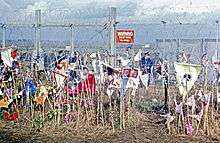
Molesworth was the focus of large protests at Easter 1985 and February 1986, during one of which Bruce Kent, one of the leaders of the Campaign for Nuclear Disarmament, attempted to cut through the fence in view of the police. A protest presence remained outside the station, recording the movement of cruise missiles, until 1990.
In later years, the Peace Garden was maintained on an ad hoc basis by a network of Molesworth Gardners. A memorial sign was erected in 1999 and replaced in June 2019.[30]
See also
- List of Royal Air Force stations
- Forrest L. Vosler, (1923 - 1992) recipient of the Medal of Honor
References
![]()
Citations
- "Defence Estates Development Plan 2009 – Annex A". GOV.UK. Ministry of Defence. 3 July 2009. p. 16. Retrieved 8 May 2019.
- https://www.bbc.co.uk/news/uk-england-suffolk-30725366 BBC News, 8 January 2015
- "Defence Minister Mark Lancaster announces release of MOD sites for development". Retrieved 18 January 2016.
- "RAF Molesworth and the 303rd Bombardment Group (Heavy)". cambridgemilitaryhistory.com. 23 December 2014.
- Jefford 1988, p. 48.
- Jefford 1988, p. 93.
- Jefford 1988, p. 63.
- Smith, John M. Airfield Focus 40: Molesworth. GMS Enterprises. ISBN 1-870384-77-6.
- "Mission report at www.303rdbg.com/" (PDF). 303rdbg.com.
- "Wulfe Hound". www.303rdbg.com.
- Statement of the Secretary of State for Defence, Francis Pym; Hansard 17 June 1980
- RAF Molesworth’s Ground Launched Cruise Missiles – 25 Years On on Heritage Daily
- Report of Investigation on Allegations Related to the DoD's Decision to Relocate a Joint Intelligence Analysis Complex (PDF) (Report). Inspector General, US Department of Defense. 30 October 2017. DODIG-2018-003. Retrieved 15 October 2019.
- "RAF MOLESWORTH & RAF ALCONBURY TO CLOSE, LOCAL MP SHAILESH VARA COMMENTS". parkfarmneighbourhoodwatch.blogspot.de.
- "Defence bases marked for closure will now be kept open". BBC News. Retrieved 1 March 2019.
- "University of Bradford Papers of Ian and Jennifer Hartley on the Molesworth Peace Camp" (PDF). brad.ac.uk.
- Jill Wallis Valiant for Peace, published by FoR 1991, page 240 ISBN 0 900368 40 3
- |Records of Architects For Peace
- Jennifer & Ian Hartley Paths are Made by Walking published by Fastprint Publishing 2013 ISBN 978 178035 552 8, page 34
- Hartley 2013, p34
- Hartley 2013, p.35
- |Papers of Tim Wallis on the Molesworth Peace Camp
- Hunts Post 27.12.86, p6.
- "Rainbow Fields is Home". Unique Publications - Independent Publishing in Glastonbury, UK.
- Hansard written answer by Minister of State for the Armed Forces, John Stanley, 11 February 1986
- Hartley 2013, p36
- |CND Cymru
- Hartley 2013, p.265-7
- T.Wallis
- |Christian CND photos
Bibliography
- Endicott, Judy G. (1999) Active Air Force wings as of 1 October 1995; USAF active flying, space, and missile squadrons as of 1 October 1995. Maxwell AFB, Alabama: Office of Air Force History. CD-ROM.
- Freeman, R. Airfields of the Eighth - Then and Now. After the Battle. London, UK: Battle of Britain International Ltd., 2001. ISBN 0-9009-13-09-6.
- Jefford, C G (1988). RAF Squadrons. A comprehensive record of the movement and equipment of all RAF squadrons and their antecedents since 1912. Shrewsbury: Airlife. ISBN 1-85310-053-6.
- Maurer, M. Air Force Combat Units of World War II. USAF Historical Division. Washington D.C., USA: Zenger Publishing Co., Inc, 1980. ISBN 0-89201-092-4.
- Ravenstein, Charles A. (1984). Air Force Combat Wings Lineage and Honors Histories 1947-1977. Maxwell AFB, Alabama: Office of Air Force History. ISBN 0-912799-12-9.
- Rogers, Brian (2005). United States Air Force Unit Designations Since 1978. Hinkley, England: Midland Publications. ISBN 1-85780-197-0.
- USAAS-USAAC-USAAF-USAF Aircraft Serial Numbers--1908 to present
External links
| Wikimedia Commons has media related to RAF Molesworth. |
- Heritage of the 303rd
- The short happy life of the Glick-em
- Airfield Focus 40: Molesworth. Author: John N. Smith. Publisher: GMS Enterprises
- RAF Molesworth entry at GlobalSecurity.org
- UPI article on NATO opening intel centre at RAF Molesworth
- Molesworth at Controltowers.co.uk
- 303d Bomb Group Website
- Cambridge Military History Website, RAF Molesworth Article
.png)